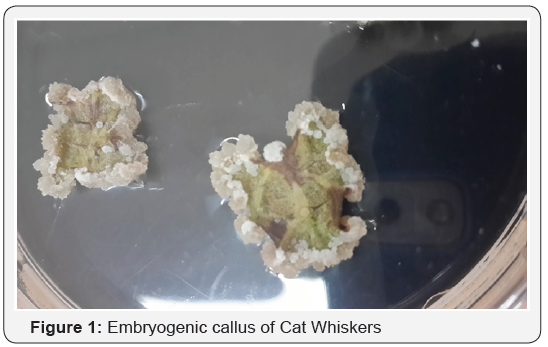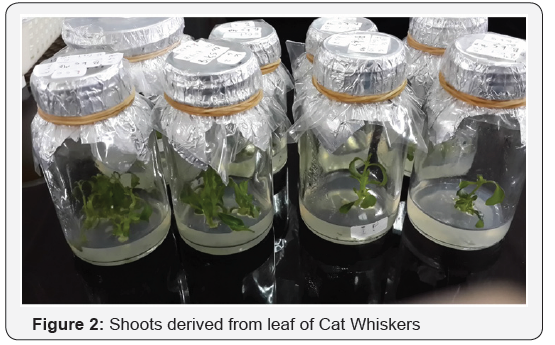Tissue Culture of Cat Whiskers (Orthosiphon stamineus)
Author: Totik Sri Mariani
Abstract
Tissue culture of cat whiskers is a method in plant
micropropagationn. However, there is still an obstacle in sinensetin
production due to a difficulty to obtain pure sinensetin. In this mini
review, development of embryogenic callus and direct organogenesis from
leaf explant are described. Using this method, we could help of plant
biotechnology to get sinensetin substance.
Keywords: Embryogenic callus; Shoot; Sinensetin; BiotechnologyIntroduction
Cat whiskers (Orthosiphon stamineus) are
commonly used as Java tea to treat kidney stones including a variety of
angiogenesis-dependent diseases such as tumorous edema, rheumatism,
diabetic blindness and obesity [1].
Embriogenic callus is the formation of callus that
could develop into somatic embryos. Supplementation of amino acid,
namely proline is necessary for the embryogenic callus formation.
Mariani [2] used proline for somatic embryogenesis of rice.
Direct organogenesis is the formation of shoot from
explant, such as leaf. Balance of auxin and cytokinins is a prerequisite
for its process. Leaf age affect the process as well.
According to Yam [3], Orthosiphon stamineus
extracts contain three flavonoids [3] as bioactive substances. Another
secondary metabolite, namely osmarinic acid was reported by [4]. They
found that the time of harvesting the plant cells from the culture
medium affected the production of rosmarinic acid in cell cultures.
Induction
The role of auxin
For embryogenic callus initiation, 50micro molar 2,
4-D was used. The embryogenic calli were sub cultured on a monthly basis
on the same medium with decreasing the concentration of 2, 4-D to 10
micromolar 2,4 -D [5]. In our study, embryogenic
callus of 2, 4-D was induced with 2 ppm of 2, 4-D. Figure 1 shows the
embryogenic callus of cat whiskers.

Physiological requirement
The physiological requirement of inducing the
embryogenic callus depends on age of explant. We used young leaves as
the explant while Smiskova et al., 2005 used immature seeds for
initiating the embryogenic callus of Schisandra chinensis. Mariani [2]
reported that scutellum of immature zygotic embryo was very good for
direct somatic embryogenesis in rice. It is due to there is storage
accumulation of protein and starch in the scutellum.
Review about the somatic embryo was explained in
Mariani [2]. Growth of embryo from leaf explant was also described in
sugarcane by [6]. Supplementation of proline in medium helped growth of
somatic embryo and embryogenic callus. Proline is
amino acids that influence physiology of the explant.
In Direct organogenesis process, shoots developed directly
on the leaf explant. Age of leaf influenced formation of shoot.
Therefore, young leaf was used in this study. Figure 2 shows
shoots of cat whiskers. Physiology of the leaf is the main factor.
Rashid [7] reported indirect organogenesis from explant of nodal
stem segment. In indirect organogenesis, shoot developed from
callus. Direct organogenesis is preferred because it is without
intervening of callus. Therefore, it could reduce soma clonal
variation.

Perspective and conclusion
Two processes in tissue culture of Cat Whiskers have
been described. These processes include embryogenic callus
induction and direct organogenesis. For the future, tissue culture
of cat whiskers (Orthosiphon stamineus) could be used for micro
propagation and production of sinensetin in horticulture.
Acknowledgement
We thank for N. Heni Hanurati for assisting in tissue culture
of cat whiskers.
For more
details JOJ Horticulture &
Arboriculture (JOJHA) please
click on: https://juniperpublishers.com/jojha/index.php
To read more…Full Text in in Juniper
Publishers click on https://juniperpublishers.com/jojha/JOJHA.MS.ID.555552.php

Comments
Post a Comment